Home
A comprehensive resource for safe and responsible laser use
UK: Petition to ban all laser pens looking for 10,000+ signatures
Claire Tucker undertook the effort out of fear for her husband Dan's safety. As of early September 2020, a Wiltshire air ambulance had been illuminated four times by laser light. Her husband was involved in at least one of those, on September 7, in which he saw 'red spots for a while after the laser caught him."
That night, Claire Tucker made an emotional appeal on Facebook, which was also put online by BBC News. In it she said, in part:
"Last night, Dan was in the helicopter, and all of a sudden, they were just about to come in to land. So all of a sudden, the laser light came in and caught Dan's goggles. So when it hits the goggles, it magnifies it. Number one: It could blind him. It could mean that he never gets to see his children again. If they were unlucky enough to hit the pilot's goggles, it could: A, blind the pilot, but B, disorientate the pilot, which will mean the helicopter hits the ground. Okay? So you're going to cause a helicopter crash… If you know anybody that has one of these lasers, please, take it off them, throw them out. Somebody knows somebody who's got these bloody lasers. Alright? It needs to stop. I do not want a knock on the door in the middle of the night by the police because the helicopter has come down."

Tucker during her Facebook appeal
She researched pointers online and found a laser pen on eBay with a claimed 50 mile range for £12 (USD $15.50). Her goal is to get laser pens banned for sale and importation.
US: Cautions about outdoor holiday laser displays
In Norfolk, Virginia, a pilot for Sentara Norfolk General Hospital told a news crew that laser light displays can be hazardous: "Every little distraction or interruption can mess with your normal routine and cause you to make mistakes and miss something that might be important." He said "Those lasers carry a long way, particularly in this cold, clear winter weather that we're experiencing right now."
The news report noted that ironically, the pilot has a laser display but he hasn't yet plugged it in on the outside of his house. He said homeowners can use them but should not aim the lasers into the sky.
From 13 News Now
Columbus, Ohio police said they are concerned with consumer drones and holiday laser lights. The laser displays "could cause the same effect as a 'laser strike' as we call it and that could blink the crew and it can become a disaster," said a Columbus Police sergeant. He also asked users to double-check where they are being aimed.
From 10 TV WBNS
UK: NPAS says only 1.4% of laser perpetrators were prosecuted
James Cunningham told Police Oracle in a March 21 2018 article that there were a number of reasons for the low prosecution rate, including being not being able to follow the laser perpetrator due to being focused on another job (e.g., completing the original mission).
Also, when lasers are pointed from a tower block area, the helicopter crew may not be able to locate the source.
In 2017 there were 67 incidents [not clear if this is NPAS only], compared with 70 in 2016 and 103 in 2015. Cunningham said the reduction is because NPAS is trying to locate and pursue laser perpetrators, and report the incidents as crime. He said the Laser Misuse (Vehicles) Bill being considered in Parliament is a “step in the right” direction that could lead to more prosecutions.
In December 2017, NPAS purchased laser-reducing glasses which can enable pilots to continue even when illuminated by laser light.
From Police Oracle
UK: New law proposes prison for aiming laser pens at aircraft, trains, cars, other vehicles
It is more stringent than the current law which 1) only applies to aiming at aircraft, 2) requires prosecutors to prove that the perpetrator endangered the aircraft and 3) has a fine of up to £2,500 (USD $3,112).
The new law will 1) apply to a wider variety of transport modes including automobiles, 2) require prosecutors only to prove that the laser was directed towards the transport vehicle and 3) will also add the prospect of prison time to the potential punishment. The exact new fines and prison terms were not stated in the DfT announcement.
Click to read more...
UK: Statistics on police helicopter laser attacks; one has been struck 100 times "over the last year"
Assuming “over the past year” means “in the last 12 months”, that would be an average of about two laser illuminations per week.
A separate article from BBC News states that in 2015 there were 91 reported laser illuminations of National Police Air Service aircraft. The largest number was 20 attacks against NPAS helicopters taking off from its Carr Gate headquarters near Wakefield, West Yorkshire.”
Reasons for the apparent discrepancy in numbers are not clear. It may be that South Yorkshire is not a member of the NPAS, which provides centralized air support to local police forces.
The BBC News chart below shows the 2015 NPAS laser attacks:
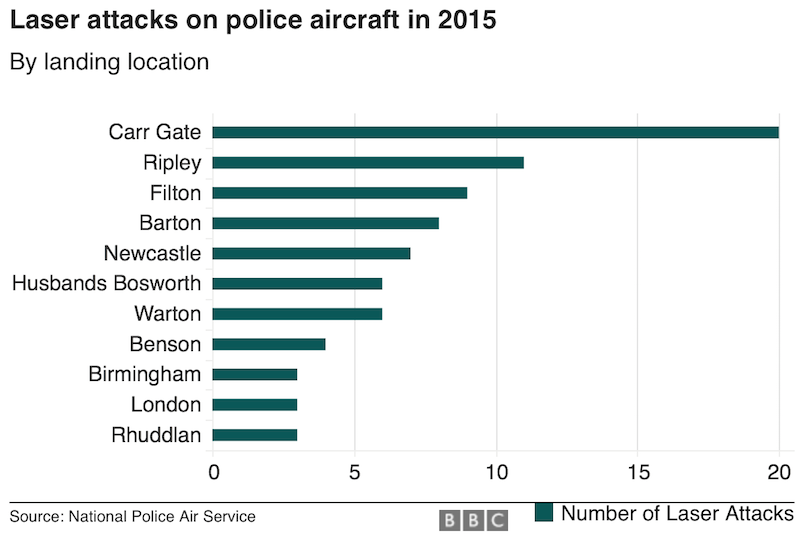
The NPAS is testing laser protective eyewear, as a means to help protect flight crews.
From The Star and BBC News. Interestingly, a September 14 search of the South Yorkshire Police website, to find more information about these incidents and police concern regarding lasers, did not find any results when searching for the term “laser.”
Finland: 60+ laser-aviation incidents in 2014; safety campaign launched
The three groups are launching a campaign to inform the public of the dangers of aiming lasers at aircraft. A Trafi spokesperson says one person was caught misusing a laser against an aircraft, but was not convicted since the court could not establish intent.
From Yle
Arizona: Pilots will seek to upgrade laser pointing penalty to felony
The first draft of the April 2014 law called for a Class Five felony to “knowingly or intentionally” aim a laser towards an aircraft. But there was concern among legislators that juveniles could end up with a felony record. The bill passed once the penalty was reduced to a Class One misdemeanor.
In a September 22 2014 story, reporter Emilie Eaton recounted Arizona’s experience. FAA-reported incidents in the state rose from 138 in 2010, to 202 in 2013. One police pilot interviewed said that he had been hit by lasers over 100 times, during a 22 year career. The pilot, Chris Potter, said he had permanent damage from a laser strike: “It literally felt like I got punched in my eye and there was a piece of debris, like a piece of glass in my eye.”
Another pilot quoted, Pima County Sheriff’s Department deputy Chris Janes, said he has has between 12 and 24 laser strikes from 2007 to 2014: “I have not received any eye damage. But I’ve had headaches afterward. I’ve had eye discomfort for several days afterward.”
From Cronkite News, via the Tucson Sentinel
UK: 1300+ laser incidents in 2013
The newspaper also reported that in the 12 months between October 2012 and September 2013, there were 31 reports of aircraft being illuminated as they approached Gatwick Airport, 30 miles south of London.
Laser strikes have also increased on rescue helicopters flying out of Redhill Aerodrome, Surrey, a few miles north of Gatwick. A tactical flight officer was quoted as saying “I've had to break away from a task because of being lasered and it's not because we're trying to catch a bad guy, it's because we're trying to find people potentially in danger.... There are certain elements of society that might be trying to harm us or put us off being in a certain location.”
Police inspector Mark Callaghan told the Mirror that there have been a number of jail terms for perpetrators, but that "Hand-held lasers are easily obtained over the internet or from market stalls and street vendors abroad. The warning labels on these are misleading and they are more powerful than advertised."
From the Surrey Mirror
New Zealand: 119 laser/aircraft incidents in 2013 help lead to 2014 restrictions
On March 1 2014, new legislation took effect which severely restricts access to lasers over 1 milliwatts only to those with a legitimate use, such as astronomers.
A Jetstar spokesman said they regarded the pointing of lasers at aircraft as highly irresponsible and welcomed the new legislation.
Air New Zealand spokeswoman Brigitte Ransom said the new regulations were a positive step in mitigating the risks.
From the New Zealand Herald and the Manawatu Standard
US: 3,960 laser incidents reported to FAA in 2013
Other news based on the statistics:
- In 2013, there were no incidents documented by FAA as causing eye injuries. Although there were incidents with eye effects such as temporary flashblindness, afterimage, blurry vision, eye irritation and/or headache, no incidents were serious enough to be tabulated as “eye injuries” by the agency. The FAA did say that in 2013, there were 35 incidents where pilots who were lased sought medical attention.
- The closer an aircraft is to the ground, the greater the likelihood of reporting a laser incident. There is a strong peak in the number of incidents at 1000-3000 feet above ground level.
- The color green was reportedly seen in the vast majority (92.8%) of incidents. Blue was a distant second with 2.4% of incidents.
- For states, California had the most incidents (734), followed by Texas (416) and Florida (326).
- For cities and regions, LaserPointerSafety has determined the Los Angeles area, including Van Nuys and Burbank, leads the nation with 147 incidents. Portland Oregon is second with 137 and Houston is third with 124. (Note that LaserPointerSafety.com tabulates regions slightly differently than the FAA or FBI, so these federal agencies may have slightly different numbers or rankings.)
- FAA tabulates each incident according to the closest airport. For 2013, Portland (Oregon) International led this category with 133 incidents. Phoenix Sky Harbor International was second with 111, and Marin International in San Juan, Puerto Rico was third with 107. This does not necessarily mean that incidents occurred at or near these airports -- just that these were the closest airports to the reported incident.
Full details are on the 2013 laser/aircraft incidents page.
UK: Toy helicopters use real lasers in a dog fight
A video showing the “AirTerminators Super Combat Helicopters” in January 2014 at the London Toy Fair shows an operator getting a brief laser hit just below his eye. The laser is said to be Class 1; if so, such a brief exposure would not be considered harmful according to safety guidelines.
However, it is not recommended for children to play with lasers. Further, it is unknown if the laser remains operational even if the helicopter is stationary or is handheld instead of free flying.
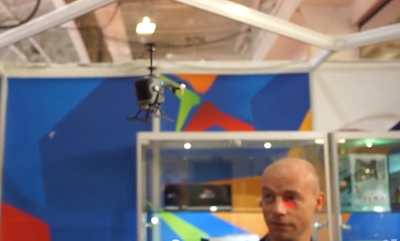
The helicopter is in the middle top of the photo. A red line can be seen just under the operator’s eye. This is the path of the laser from an opposing helicopter as it went across his face during the video frame. This can be seen at 34 seconds into a YouTube video of the demonstration.
From Pocket-Lint. The video is on YouTube.
US: UPDATED - Arizona bill to make aiming a laser at aircraft a felony
The Tucson Police Department had about 50 lasing incidents in 2013; the perpetrator was caught in most of the cases. But there was little prosecution.
Orr says the bill is needed because “there’s really no punishment. The county prosecutor, because it's not at a felony status, doesn't go after them. And so literally, you get a ticket and nothing happens. But you're endangering lives."
Orr is working with Tucson police pilot Chris Potter, who says he has been hit by a laser pointer about 100 times in his career. Potter says a laser pointer permanently damaged his right eye around 2011.
According to News 4 Tucson, “the FBI will launch a public awareness campaign about the issue next month.” It was not clear if this was an Arizona-area initiative or nationwide.
From News 4 Tucson
UPDATED - February 4 2014: The Arizona House Judiciary Committee voted in favor of increasing the penalty for persons who point lasers at aircraft. HB 2164 would make it a Class 5 felony, with a presumptive sentence of 18 months in prison, to knowingly or intentionally point a laser at an occupied aircraft. And the penalty would go to 30 months if the act disables the pilot or causes serious physical injury to anyone on board. The legislator who introduced the bill, Ethan Orr, is considering reducing the penalty slightly, to a Class 6 felony, when it goes to the full House. Prosecutors could reduce the charge from a felony to a misdemeanor when appropriate. Orr said this might be the case for youths so that a single mistake would not result in a felony record. From KWST.com. A related article at AZCentral.com includes comments from LaserPointerSafety.com’s Patrick Murphy on the issue.
UPDATE 2 - May 1 2014: The bill was eventually amended to make the act of aiming at an aircraft a Class 1 misdemeanor. The act became an assault if the pilot was unable to safely operate the aircraft or if anyone onboard suffered a serious physical injury. The amended version passed both legislative bodies and was sent to Governor Jan Brewer, who signed it on April 30 2014. From the Arizona State Legislature legislative history of HB2164.
UPDATE 3 - September 23 2014: The Arizona Police Association and other law enforcement groups want to increase the penalty to a felony. They hope to introduce a measure when the legislature re-convenes in January 2015.
US: Tucson police pilot says he has permanent retinal damage from laser exposure
The statement came as hundreds of Arizona law enforcement pilots attended a safety seminar in Tucson focusing on laser beam incidents. In 2012 in Tucson alone, the police department’s air unit had “close to 50 incidents”, according to Potter. As of November 2013, Phoenix was the top U.S. city for laser incidents.
From KVOA News
Canada: Laser strikes up significantly in Edmonton
A police pilot spokesperson said laser users are not reading the packaging which clearly states not to aim at aircraft. After being caught, "There's been a lot of apologies, a lot of regret, some people not realizing the consequences of what they were doing, and then there's been the far opposite -- I can't believe this is happening, this is ludicrous, this isn't serious, it's just a laser pointer."
The pilot also said that a ban is not the answer: "If it's used properly, it's harmless. It's hard to ban something like that, the sale of it completely if 95% of the general public are using it properly."
He noted that not just police aircraft are being lased. Commercial and private aircraft also are at risk.
Edmonton police helicopter pilots are equipped with safety glasses for use during laser illuminations. They have two pair, one to attenuate red laser light and one to attenuate green laser light.
For details on the two most recent Edmonton incidents, on September 6 and 7 2012, see this LaserPointerSafety.com story.
From the Edmonton Journal and Edmonton Sun. Thanks to Keith Murland for bringing this to our attention.
US: $208 million contract to protect Army helicopters from laser threats
The Army/Navy Piloted Aircraft/Visual and Visible Light/Receiving, Passive Detecting (AN/AVR-2B) Laser Detecting Sets (LDS) uses four sensor units placed on the aircraft. It is smaller, lighter and uses less power than a previous generation developed for the cancelled Comanche helicopter program.
News reports did not state how much it costs to equip each helicopter with an AN/AVR-2B system.
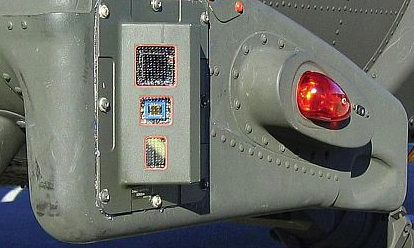
One of the four sensor packages to detect laser threats on U.S. military helicopters
From Avionics Intelligence August 31 2013 and September 3 2013
US: FAA study compares fixed-wing airplane laser incidents with helicopter incidents
The study found that helicopters were 3.4 times as likely to be illuminated at altitudes below 2,000 feet than fixed-wing aircraft. Helicopter aircrews were twice as likely to report adverse effects such as distraction, vision interference, operational problems, and pain.
The study also broke down adverse effects by the type of flight, such as commercial, law enforcement, medical and military.
One conclusion of the study is that the “results may also justify the expense of equipping rotary-wing aircraft (particularly law enforcement aircraft) with laser detection and tracking devices to improve the possibility of apprehending perpetrators of these offenses.”
A detailed summary is at LaserPointerSafety.com’s 2013 FAA helicopter study webpage. The full 6-page report is available online from the FAA.
UK: More than 220 laser attacks in two years in West Midlands, says CAA
This is roughly one-third of the 700 incidents over the same time frame that involved aircraft in or above the West Midlands. (The 480 non-laser incidents included bird strikes, emergency landings, a bomb threat, a dog on the runways and closure of an airfield because of a flying kite.)
On one occasion in July 2011, four different lasers were aimed at a police helicopter in a single incident.
The British Airline Pilots’ Association asked for prison sentences for persons caught aiming at aircraft, as well as regulations over the sale of high-powered lasers.”
According to West Midlands police, laser attacks on their helicopter have fallen in months prior to July 2013.
From the Birmingham Mail. See also a related LaserPointerSafety.com article on BALPA’s laser pointer suggestions.
Egypt: First-person account detailing laser use during Cairo protests
A new, first-person account from Egypt states that laser pointers were originally used to harass snipers and lookouts using binoculars, and to irritate political enemies. However, the dramatic use of dozens of lasers aimed at Egyptian army helicopters was intended as friendly, being used to “greet” the military who by this time was on the side of the protesters.
(It needs to be noted that, regardless of intent, laser light can flashblind and disrupt pilots. Due to the potential flight and crash hazards, it is illegal in the U.S. and many countries to even aim a laser towards an aircraft.)
Click to read more...
Egypt: Dramatic photo of lasers on helicopter was Photoshopped

The bright rays and the lens flare effects were not captured by the camera but were added later. This may have been done for artistic effect, or to make the lasers look more dangerous. However, this incident does serve as a reminder that “you can’t always believe what you see”.
Egypt: UPDATED - Dozens of laser pointers used in protests to simultaneously paint helicopters
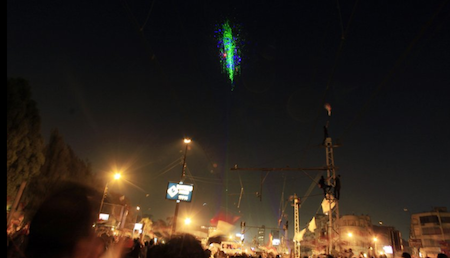
An aerial view, as seen on Egyptian network Capital Broadcasting Center, gives an idea of what the lasers looked like approaching Tahrir Square. In this scene, there is one blue beam and roughly 30 green beams.
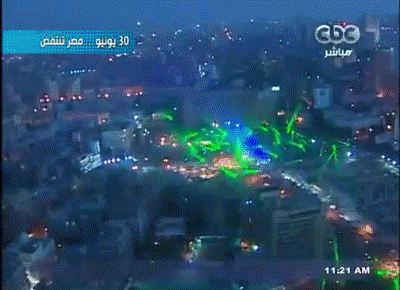
Animated GIF via “Cyparagon”. The original video can be viewed here (the aerial laser segment starts about halfway into this video).
There have been no reports of injuries to the air crews, or of the laser light causing the pilots to lose control. [UPDATE, July 8 2013: A first-person account states that the pointers were friendly, intended to “greet” the army pilots who at this point were on the side of the protesters.]
US: L.A. Sheriff's Dept. puts "Laser Strike" info video on YouTube
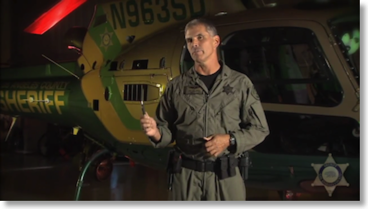
To see the video, click this link to YouTube. Following this link should also lead to the bonus content videos.
To get a flavor of the training video, click the “Read More…” link below for a list of selected excerpts and interesting statements.
US: Myrtle Beach area proposed ban on laser pointer sales
The ordinance would make it illegal to sell lasers over 1 milliwatt, or to sell any green laser to persons under 18. Adults misusing lasers would be charged with assault and battery, with a fine of up to $500, up to 30 days in jail, and being held liable for any damage or personal injury. Minors misusing lasers would be prosecuted in Family Court, plus parents would be held responsible and could be fined or jailed.
In addition, a warning would be required with the sale of every laser pointer.
Under county procedure, it takes three “readings” at council meetings to pass an ordinance. Based on the council’s schedule, the earliest it could be passed would be in January 2013.
From CarolinaLive. This is part of continuing stories at LaserPointerSafety.com about ongoing problems at Myrtle Beach and North Myrtle Beach.
US: Myrtle Beach considering further laser regs; current ones aren't working
A meeting was held with local officials, including representatives from Myrtle Beach, the Coast Guard, the Chamber of Commerce and the Horry County Council, to discuss options. The director of airports said that existing ordinances are not enough. He wants “a way to look at regulating the size and power of lasers that are sold in our community and region.”
Rather than local cities passing ordinances, one approach is for county-wide regulations. The topic will continue to be discussed at future county council meetings.
From CarolinaLive. This is part of continuing stories at LaserPointerSafety.com about ongoing problems at Myrtle Beach and North Myrtle Beach.
US: 198 calls to police about lasers in 3 months; Coast Guard "cracking down" in Myrtle Beach
The local Coast Guard echoes the concerns. Twice in two weeks, search and rescue missions were ended prematurely because of lasers being aimed at helicopters. (See a report here.) Under Coast Guard regulations, after laser exposure the aircraft is grounded and the pilots are medically evaluated before being allowed to fly again.
The Coast Guard issued a letter asking the public to stop aiming at aircraft, and saying that they want to enforce South Carolina’s state law against lading aircraft. The letter is reprinted below (click the “Read More” link).
From WMBF News. This is part of continuing stories at LaserPointerSafety.com about ongoing problems at Myrtle Beach.
Click to read more...
US: "Epidemic" of laser misuse in Myrtle Beach
Laser pointers are available for as little as $4 at many beachfront stores catering to tourists.
The president of a Myrtle Beach helicopter tour company says that his aircraft are hit “two, three times a week, sometimes more.” He says the increase makes him nervous for his pilots and clients. He says there is no education for laser pointer buyers about the potential hazard.
Click for video interview with Huffman Helicopter president Jeremy Bass.
From CarolinaLive. This is part of continuing stories at LaserPointerSafety.com about ongoing problems at Myrtle Beach.
Scotland: 107 laser incidents in Glasgow in 2011
From the Scotsman
UK: CAA issues Safety Notice to pilots, after 2,300 laser attacks in 2011
Below are highlights from the document, which gives some background information and statistics, and then describes how affected crew should prepare for and react to a laser attack. (Emphasis in bold added by LaserPointerSafety.com.)
Click to read more...
South Africa: 181 laser incidents in 2+ years
On March 25 2012, an ATNS statement noted that air traffic control towers have been illuminated by laser light, in addition to airplanes and helicopters. ATNS said there have been at least two arrests, but thus far, no prosecutions.
South African aviation groups are joining together to publicize the hazards and penalties of aiming lasers at aircraft. They are also considering strengthening laws. According to the statement, laser ownership requires a permit, but illegal sales are taking place via imports and black market stores.
From The Star via Independent Online, News 24, and the Daily News. Thanks to Dr. Ian Powell for bringing this to our attention. The ATNS press release is after the link (click “Read More…”).
Click to read more...
US: 2011 total: 3,591 laser/aircraft incidents
Note: The FAA reports the 2011 total as 3,592. This is because the last entry in the FAA’s laser incident spreadsheet is on line 3,592. However, the spreadsheet headings are on line 1, so the actual number of 2011 incidents is 3,591 -- the number we use below.
What is an FAA-reported “laser incident”?: This is defined as an aircraft pilot seeing one or more laser beams during flight. A mid-2011 study by Rockwell Laser Industries of 6,903 incidents reported to the U.S. Federal Aviation Administration found that in 27% of incidents, beams entered the cockpit (passed through the windscreen). For example, in 2011, there were 3,591 incidents of which approximately 970 (27%) involved beams in the cockpit.
PowerPoint version available: A set of slides, presented to the SAE G10 aviation safety committee on Jan. 31, 2012, is available on the Files and Downloads page.
Yearly Comparison
Here are the number of incidents reported to FAA in recent years:- 2011: 3,591 incidents (9.8 per night)
- 2010: 2,836 incidents (7.7 per night)
- 2009: 1,527 incidents (4.2 per night)
- 2008: 949 incidents (2.6 per night)
- 2007: 639 incidents (1.8 per night)
- 2006: 384 incidents (1.1 per night)
- 2005: 283 incidents (0.78 per night)
- 2004: 46 incidents (0.13 per night) involving an unknown number of aircraft Note: FAA mandated that pilots report incidents using Advisory Circular 70-2, beginning January 19 2005. Before this date, pilot reporting was voluntary.
This is a total of approximately 10,201 incidents reported to FAA, from 2004 through the end of 2011.
Adverse Effects
In 55 of the 3,591 laser/aircraft incidents (1.5%), a pilot or aircraft occupant reported a temporary adverse visual effect such as flashblindness, afterimage, blurry vision, eye irritation and/or headache. None of these effects was classified as a recordable injury by FAA medical experts.In these 55 incidents…
- … there were 31 reports of pain or discomfort in the eyes or elsewhere (e.g., headache).
- … there were 31 reports of vision impairment such as afterimages (10) and blurry vision (7).
- … seven persons sought medical treatment after the laser exposure.
- … one person was grounded temporarily.
- … three flights were affected: in two cases, the pilot turned control over to the co-pilot; in one case the pilot felt he had to land immediately.
Rate of increase, by year
While laser incidents continue to increase, during 2011 the rate of increase slowed significantly.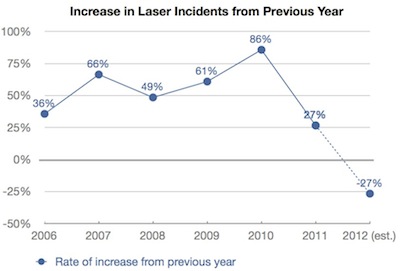
The rate of increase dropped 59% in 2011 (from 86.4% to 27%). If there is another 59% drop in 2012, (dashed line), then there would be a decrease in laser incidents for the first time, from 3,591 incidents in 2011 to 2,836 incidents projected for 2012.
Click to read more...
South Africa: 70 incidents in 2011, including a go-around; no arrests
The majority of South African incidents occurred in Cape Town, with other reports at OR Tambo, Wonderboom in Pretoria, and Lanseria International. In an incident in Lanseria, “two pilots were blinded so badly that after landing they couldn’t see the man who signaled where to park the plane” according to News24.com.
There were no persons arrested during 2011 for aiming a laser at aircraft. Over all years, there have only been two incidents resulting in arrests (as of January 11 2012):
- Around January 7-8 2012, three persons were arrested for pointing green laser beams at helicopters using the Bloemfontein civil and Air Force airports.
- During the 2010 World Cup, a man temporarily blinded a helicopter pilot in Durban
A Civil Aviation Authority spokesperson said “It is a serious hazard to point laser lights at aircraft.” The maximum penalty for an offense is a “hefty fine and up to 30 years in jail.”
The general manager of the Air Line Pilots Association of South Africa said ALPA-SA members were reporting increasing numbers of incidents where “sudden and intense bursts of light [are] deliberately shone at aircraft…”
From The New Age and DefenceWeb
Commentary from LaserPointerSafety.com: The figure of 70 incidents reported to ATNS in 2011 is probably low. A May 5 2011 news story quoted ALPA-SA as saying they receive between 10 and 12 complaints from pilots every week. That would result in 520 to 624 laser illuminations per year. Also, the 70-incident figure may be a misunderstanding or misquote. A news story from March 2011 quotes ALPA-SA as saying there were 70 incidents in the 10 months from April 1 2010 through February 28 2011; see News24.com.
.
US: Los Angeles TV news report about increasing laser pointer incidents
KABC quoted the Glendora regional police helicopter tactical flight officer who was illuminated as saying “The laser could cause [eye] damage, and there’s a potential for the helicopter to crash.” The report said he and a pilot were recently trained by the FBI in how to handle a laser attack and how to track down a suspect.
Laser incidents are rising both nationwide and at local airport Los Angeles International (LAX), stated the report. It concluded by reminding the public that “any offense jeopardizes the safety of everyone.”
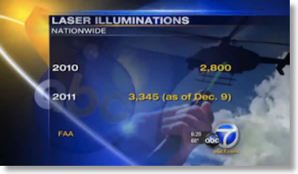
Click the screenshot above to view the video report from KABC
From KABC
Wales: Eight people convicted of laser offences thus far in 2011
A spokesperson noted that several of the arrests involved young people. He said, “We’re hoping parents will see this message so they can remind their children, if they have access to laser pens, not to use them irresponsibly.”
According to the news story, the maximum penalty for recklessly or negligently acting in a manner likely to endanger an aircraft is a fine up to £5,000, and/or five years imprisonment.
From NewsWales. One LaserPointerSafety.com news item about a 2011 Wales conviction is here.
Switzerland: Air rescue pilots to use laser protective eyewear
The action was taken because laser attacks are on the rise: six in 2009, 11 in 2010 and 16 to mid-October in 2011.
The sale of strong laser pointers was banned in Switzerland in May. The Federal Health Office is currently reviewing the possibility of banning their possession and use. Checks carried out by the Federal Office of Metrology this year showed that more than 95 per cent of the pointers tested were stronger than the permitted limit.
From SwissInfo.ch
US: Ocean City NJ discusses a ban on laser pointers
The move came after a report one week earlier about seven incidents when aircraft landing at Atlantic City International Airport had been illuminated by lasers. Police noted that while pointing at an aircraft is a crime, owning or selling lasers is not against the law.
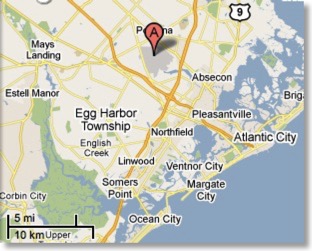
Ocean City, New Jersey, location in relation to Atlantic City International Airport (“A” on the map above)
From the Press of Atlantic City. An earlier story (August 18 2010) has additional details about the aircraft illuminations and the efforts to stop sales; see this Press of Atlantic City article. A January 23 2011 Press of Atlantic City article updates the laser situation in the Ocean City area.
Related LaserPointerSafety.com news stories about Ocean City and New Jersey laser troubles
- August 26 2010: Ocean City officials discuss city-wide ban on laser pointers after summer incidents.
- November 22 2010: State senate bill 2430 is introduced in November 2010 to ban laser pointers above 1 milliwatt.
- June 8 2011: Man buys laser in Ocean City, points it at helicopter, and is almost immediately arrested.
- June 11 2011: Residents report harassment; voluntary sales ban is not working.
- June 24 2011: Unanimous vote on the initial measure to ban Ocean City laser pointer sales and possession.
- July 14 2011: Unanimous vote on the “second reading” to make the Ocean City ban official.
- April 16 2013: North Wildwood NJ bans sale and possession of laser pointers above 1 mW.
- August 20 2013: New Jersey state legislature passes bill to ban laser pointer sales above 1 mW; sends bill to Governor for signature.
- October 17 2013: Governor Chris Christie vetoes bill to ban laser pointer sales, saying the 1 mW power limit was “arbitrary” and there was no criminal use of lasers between 1 mW and the federal limit of 5 mW in New Jersey.
South Africa: Incidents are increasing; pilots express concern
A representative of the Civil Aviation Authority said that laser misuse violates two sections of the Civil Aviation Regulations, and can be punished with a fine and/or imprisonment of up to 10 years. (There was an arrest in 2010 during the World Cup, when 35-year-old Yusuf Ebrahim temporarily blinded a helicopter pilot.) The CAA representative said the Authority would consider new standards or regulations if they were recommended by the International Civil Aviation Organization.
To report a laser illumination incident in South Africa, CAA said to email information to cahrs@caa.co.za or fax it to 011 545 1453.
From Independent OnLine Scitech. An IOL story about Yusuf Ebrahim’s first court appearance is here.Click to read more...
US: FAA to impose civil penalties of up to $11,000
The Wall Street Journal states that “[t]he change is intended to make it easier to punish violators without resorting to time-consuming criminal proceedings.”
Previously, FAA did not go after laser violators directly. FAA will now routinely bring civil charges, and these will be in addition to any other civil or criminal charges brought by others such as the FBI, or state and local law enforcement.Click to read more...
US: FBI to use laser event recorders in cockpits
OPTRA Inc. Awarded Purchase Contract by U.S. Federal Bureau of Investigation to supply Laser Event Recorders
Topsfield, MA (June 15, 2010) - OPTRA Inc. was awarded a contract by the U.S. Federal Bureau of Investigation (FBI) to supply Laser Event Recorders (LER). The LERs will be used to fight the laser dazzle problem that has become an increasing problem for pilots worldwide in recent years.
The problem that pilots have been facing in increasing numbers is from people on the ground that point hand held laser devices at aircraft. Some of these lasers have a range of up to 5 miles and in some cases can cause temporary blindness for the pilot that could result in loss of control of the aircraft. With the LER being used in the cockpit of an aircraft it is possible to detect a laser pointed in the direction of an aircraft and allow the pilot to avoid eye contact while at the same time capturing critical information that can be used to locate, apprehend and prosecute the offender.
Click to read more...
UK: Laser beam air attacks on rise
Some of the more interesting quotes:
- Pilot Kevin Medlock: "It's so brilliant, it takes away part of your vision for a few minutes at least. We fly an aircraft, 148 passengers, making an approach to landing at 170 miles per hour. The consequences of someone shining a laser in my eyes at that stage of flight isn't worth bearing the consequences." Medlock was hit by laser beams twice in one month.
- "What's worrying experts is the rate at which the problem is growing:" 29 U.K. attacks in 2007, 206 attacks in 2008, and 461 in 2009 (through September).
- (video of teen walking into court) "This man said he was trying to see how far his laser could reach. Dean Bottomley was sent to jail."
- Captain Bob Jones, U.K. Civil Aviation Authority: "We're trying to raise the awareness of the general public, rather than worry or frighten them."
From BBC News
UK: Police "fight back" by tracking laser hits

1: Police helicopter is targeted by laser pointer on the ground. 2: Helicopter crew use Laser Event Recorder to locate pointer via GPS, and record its wavelength. 3: GPS details enable helicopter’s thermal (infrared) camera to find suspect, and send police patrol on the ground to arrest the person.
In addition, the UK’s Civil Aviation Authority is planning new laws prohibiting shining a laser at an aircraft. Currently, prosecutors have to prove that the laser user “recklessly or negligently endangered an aircraft”.”
BBC quotes Bob Jones, head of flight operations at the CAA: “"To those individuals targeting aircraft with laser devices the message is clear -- don't. You will be caught and you will be prosecuted and you could spend up to five years in prison. These things are not toys, they pose a serious risk to all flight safety."
Many more details, including photos and a video of a helicopter finding a laser perpetrator, are at the BBC News website.
UK: Growing concern over laser pointers
The pilot, who was over Stockport at the time, was temporarily blinded. Unable to read his instruments, he had to make dangerous emergency manoeuvres.
This case highlights a growing concern about the inappropriate use of more powerful green laser pens or pointers.
Britain's largest pilots union BALPA has recently warned of a major air disaster unless action is taken.
Click to read more...